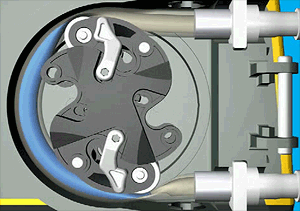Inside a cheap bubble blowing toy

My wife picked up a cheap (6USD) bubble blowing toy. Ever since we got it I’ve been at least as fascinated by it as our child. Perhaps slightly less enamoured with the repetitive melody it produces however.
As always though, I find it amazingly how much they pack into these cheap mass produced consumer products and the corners that get cut to reduce costs.
What particularly interested me was that it uses a peristaltic pump to push the soap mix toward what I call the “bubble formation aperture”. I’ve been reading about peristaltic pumps recently because they’re often used to deliver accurate volumes of liquid for scientific and medical applications.
The pump is named after the contractions the intestine makes to push food through your digestive tract and it operates in the same way. The gif to the left (shamelessly stolen from the wikipedia page), shows how fluid is pushed along.
This toy uses this exact mechanism, because it’s transparent you can see the pump operating without taking the toy apart which is also pretty neat and a nice learning aid. The gif below shows the toy operating and you can clearly see the pump working away.
 In order to create bubbles the toy needs not only to deliver the fluid in a controlled manner and allow it to form a film, but to force air through the film in order to create bubbles. This uses the simple (but I still think rather nicely designed) fan assembly shown to the right.
In order to create bubbles the toy needs not only to deliver the fluid in a controlled manner and allow it to form a film, but to force air through the film in order to create bubbles. This uses the simple (but I still think rather nicely designed) fan assembly shown to the right.
Both the fan and the pump are driven by the same motor. This is a dual shaft motor, which looks something like this:
 In order to keeps costs low the toy uses a couple of other neat tricks. The first is the usual ultra-cheap PCBs that are used in these kinds of toys. Single layer and massless. Rather than being CNC routed out I’ve heard these are punched out, given than normal PCBs cost almost nothing, these must be practically free. Again, as is common it uses a dye on PCB with a blob of epoxy on it. This actually isn’t required for the general operation of the toy, it’s only used to synthesise the annoying music the toy produces (and flash the LEDs).
In order to keeps costs low the toy uses a couple of other neat tricks. The first is the usual ultra-cheap PCBs that are used in these kinds of toys. Single layer and massless. Rather than being CNC routed out I’ve heard these are punched out, given than normal PCBs cost almost nothing, these must be practically free. Again, as is common it uses a dye on PCB with a blob of epoxy on it. This actually isn’t required for the general operation of the toy, it’s only used to synthesise the annoying music the toy produces (and flash the LEDs).

One final trick is the omission of any kind of power switch. The trigger just has a spring connected to it. The battery ground is connected to this spring and when the trigger is press it shorts against the motor chassis to complete the circuit. That’s a serious hack to avoid a real switch or an extra metal plate. But when the product costs 6USD and I would imagine an order of magnitude less to manufacture. Every penny must count.
Update
 I’m impressed by how robust the toy is. Even though it’s in no way water tight it’s still operational after being fully submerged. The rear LED failed but everything else works. I put this down to the simplicity of the electronics and the fact that the IC is enclosed in resin. But it looks the motor housing maybe more or less water tight. Pretty impressive in any case.
I’m impressed by how robust the toy is. Even though it’s in no way water tight it’s still operational after being fully submerged. The rear LED failed but everything else works. I put this down to the simplicity of the electronics and the fact that the IC is enclosed in resin. But it looks the motor housing maybe more or less water tight. Pretty impressive in any case.

